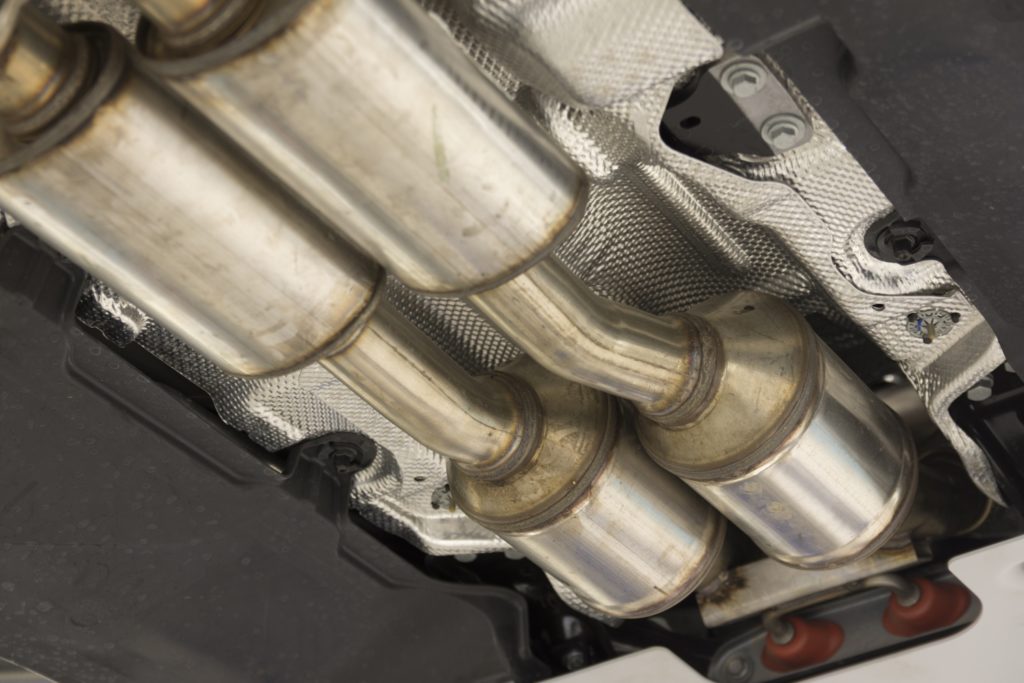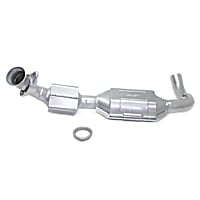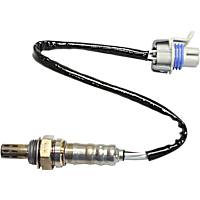Code P0036 is a generic diagnostic trouble code (DTC) that’s set when there’s a potential fault in the downstream oxygen (O2) sensor’s heater circuit.
Have you recently read code P0036 on your OBD-II scanner? Find out what it means, what causes it, and what could be the possible symptoms you might face. Here are the things you need to know before troubleshooting the P0036 code.
What Does the Code P0036 Mean?
Diagnostic Trouble Code (DTC) P0036 Code stands for HO2S Heater Control Circuit (Bank 1 Sensor 2). The P0036 code gets set when the PCM perceives a potential problem with the bank 1 sensor 2 O2 sensor heater control circuit. Sensor 2, referred to as the downstream sensor, is after the catalytic converter while bank 1 points to the side where the cylinder #1 is located. Most modern vehicles use a heated oxygen sensor (HO2S) that has a heating element that quickly brings the sensor to operating temperatures.
Note: If you want to learn where Bank 1 is, you can read our guide here.

The downstream (post-converter) HO2S primarily gets used for post catalyst monitoring. It does this by checking the oxygen content of the exhaust gas after exiting the catalytic converter. Each HO2S compares the oxygen content of the surrounding air with the oxygen content in the exhaust stream.
The heater circuit may get supplied power or ground by the PCM, which brings the sensor up to operating temperature rather quickly. Typically, the PCM controls the HO2S’ heater circuit based on the signals from the engine coolant temperature and engine load.
The HO2S has to reach the optimal operating temperature (typically 570°F) to ensure that it’s sending accurate voltage signals to the PCM. The faster the heated oxygen sensor reaches that temperature, the faster the sensor will start sending an accurate signal. The heater circuit minimizes the time needed for this to happen.
You can learn more about how and why oxygen sensors are heated here.
If the PCM detects that the HO2S is not sending the right signal or not sending a signal at all, it will store code P0036 and illuminate the check engine light.

P0036 on Some Chevrolet Vehicles
HO2S are used for fuel control and post catalyst monitoring. Each HO2S compares the oxygen content of the surrounding air with the oxygen content in the exhaust stream. The HO2S must reach operating temperature to provide an accurate voltage signal.
The ECM uses pulse width modulation (PWM) to control the HO2S heater operation to maintain a specific HO2S operating temperature range.
Code P0036 may appear on some Chevrolet vehicles. On a 2008 Chevrolet Silverado 1500 LS 4.8L V8, for example, conditions for setting the DTC include:
- The ECM detects that the affected HO2S heater low control circuit is not within a specified range
- DTC P0036 is set within 3 seconds when the above condition is met.
What are the Possible Causes of the P0036 Code?
Even though code P0036 is a generic code, meaning it applies to a variety of vehicles with on-board diagnostics, the reasons for its storage by the PCM can vary from one vehicle to another. A P0036 on a Chevrolet may differ from one on a Honda in terms of which component is causing the issue. Other factors may affect it, including the layout of a certain system and the overall design of the vehicle.
If you’re wondering why your OBD-II sensor is giving you a P0036 code, it could be one of these causes:
- A faulty oxygen sensor (a healthy heater usually measures about 6 ohms)
- A problem with the O2 sensor heater control circuit, such as damaged wires or poor connections
- An issue with the ECM, such as software in need of an update
Quick tip: Get an old O2 sensor connector and wire a small light bulb to the two wires that are the same color on the connector (white, brown, black, etc.). These two same-color wires are the wires that feed the heater. When you start the truck with this homemade tool plugged into the harness in place of the suspect sensor, the light should come on. If it doesn’t, find out why. Don’t neglect to check fuses.
What are the Common Symptoms of the P0036 Code?
There can be no observable symptoms for code P0036 other than the most common one you may get with any other DTCs, which is an illuminated check engine light. If you bring your car to an emissions testing facility, the check engine light may give you a failed result.

How to Diagnose the P0036 Code
To resolve the P0036 code, you need to pinpoint its exact cause first, but this can be a bit difficult. From a DIY-er point of view, it might appear to be simple and easy. However, for the emission control system of your car, you should not risk working on it alone. For better results and proper assessment, seek your trusted mechanic.
How to Fix the P0036 Code
There are several possible reasons behind the powertrain control module (PCM) logging the P0036 code. You must identify the faulty part, determine how it failed, and then either repair the issue or replace the part.
Oxygen Sensor Fuse in Heater Circuit
The heater circuit helps raise the oxygen sensor’s temperature to operating levels. One of its components is a fuse that helps heat the sensor.
If something goes wrong with the oxygen sensor, such as a short that might damage the device or the circuit, the fuse will blow. An oxygen sensor with a blown fuse won’t operate until you replace the fuse.
Perform a visual inspection of the oxygen sensor fuse. If you find a blown fuse, replace it with a new one. Usually, you don’t have to replace the sensor itself.
Damaged Wires in the Heater Circuit
Many cases involving the P0036 code often involve the heater circuit wiring. Power wires carry electrical current to the heater, providing the device with the power it needs to heat the oxygen sensor.
On the way to the heater, the power wires pass by the exhaust system. If a power wire touches the catalytic converter or another exhaust system part, the intense heat can short out the wire or possibly the oxygen sensor circuit.
Most vehicles have wiring clamps that hold the wires back from the exhaust system. Unfortunately, the plastic that makes up these fasteners can melt when exposed to high temperatures, such as the heat produced by the exhaust. If a wiring clamp melts, the power wire falls free and can come into contact with the hot exterior of the exhaust system.
Inspect the wires connected to the heater circuit. Look for any visible signs of damage to the wires, such as burned, frayed, and melted segments. In many cases, you can repair the damaged wires. If you do replace the wires, use the right type.
Rear Oxygen Sensor (Bank 1, Sensor 2)
A faulty bank 1, sensor 2 oxygen sensor can trigger the P0036 code. This sensor can be found on the same side of the engine’s number one cylinder and after the catalytic converter. If the oxygen sensor goes bad, you must replace it.
Oxygen Sensor Wiring Harness
The oxygen sensor relies on wires of its own to receive power and send its signals to the powertrain control module. Like the heater circuit wires, the wiring harness can get damaged. You must replace a harness with damaged wires.
Powertrain Control Module
In rare cases, an issue with the powertrain control module can lead to the P0036 code getting logged. While you can sometimes fix the PCM issue, you might have to replace the computer.
Resolving the P0036 code can vary from vehicle to vehicle. Some cases will be very different from others. Check your owner’s manual or trusted online resources to clarify anything that confuses you. If you aren’t confident about the DIY repairs required to fix the P0036 trouble code, ask a trusted mechanic for help.
Getting Your Hands on New Auto Parts to Fix DTC P0036
One of the easiest ways to fix DTC P0036 is to identify faulty parts and have them repaired or replaced as soon as possible. Common culprits include bad wiring and faulty O2 sensors. Fortunately, finding a replacement sensor is easy with the help of CarParts.com.
The best part? You won’t have to take one step outside your home to shop for the parts you need. To get started, visit our website or download our mobile app. Input your vehicle’s year, make, model, and engine into our vehicle selector. This way, you’ll have a much easier time finding compatible auto parts for your ride.
We source our products from only the most trusted names in the industry. Each item in our catalog is vetted by a team of professionals to guarantee fit, performance, and reliability.
You also won’t have to break the bank since each item in the catalog is set at competitive prices.
Fix DTC P0035 by browsing our catalog for replacement parts now at CarParts.com.
Products Mentioned in this Guide
Any information provided on this Website is for informational purposes only and is not intended to replace consultation with a professional mechanic. The accuracy and timeliness of the information may change from the time of publication.


 Catalytic Converter
Catalytic Converter
 Oxygen Sensor
Oxygen Sensor
















